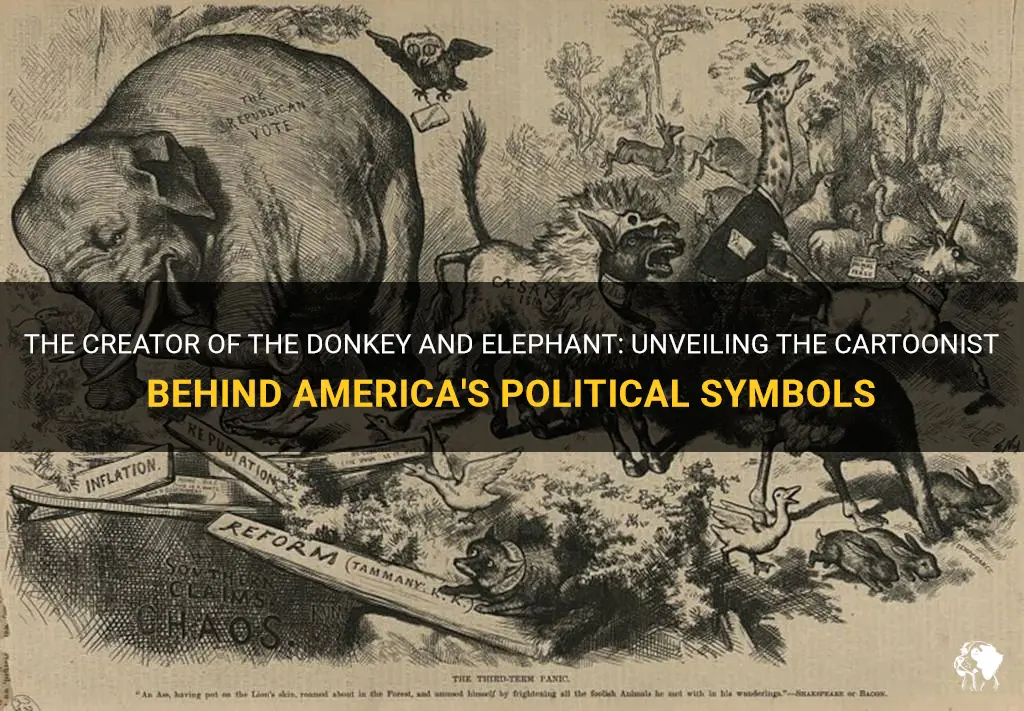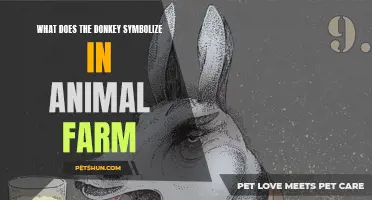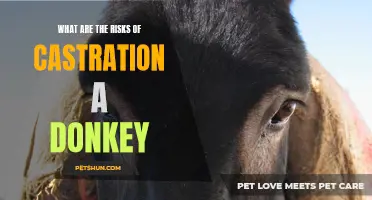
In the whimsical realm of politics, there are two iconic symbols that have come to represent the two major political parties in the United States: the donkey and the elephant. These whimsical creatures have become synonymous with American politics, instantly recognizable to even the most casual observer. But, have you ever wondered who first breathed life into these symbolically charged characters? Today, we delve into the world of political cartooning and explore the origins of the donkey and elephant, uncovering the creative genius behind these enduring symbols: the legendary cartoonist who gave them shape and personality.
| Characteristics | Values |
|---|---|
| Cartoonist | Thomas Nast |
| Date | 1870 |
| Donkey symbol | Democratic party |
| Elephant symbol | Republican party |
What You'll Learn
- Which cartoonist is credited with creating the donkey and elephant symbols for the Democratic and Republican parties in the United States?
- What was the inspiration behind the donkey and elephant symbols in political cartoons?
- How have the representations of the donkey and elephant evolved over time in political cartoons?
- Are there any other animals or symbols commonly used to represent political parties in other countries?
- How do cartoonists use the donkey and elephant symbols to convey political messages or satire in their work?

Which cartoonist is credited with creating the donkey and elephant symbols for the Democratic and Republican parties in the United States?
In American politics, the donkey and elephant symbols are widely recognized as representing the Democratic and Republican parties respectively. These symbols have become ingrained in the political landscape, but have you ever wondered who was responsible for their creation? The answer lies with a talented and renowned cartoonist named Thomas Nast.
Thomas Nast, a German-born American, was a political cartoonist who lived from 1840 to 1902. He is often referred to as the "Father of the American Cartoon" due to his significant contributions to the field. Nast's illustrations played a crucial role in shaping public opinion during a time of great social and political change in the United States.
It was in the late 19th century when Nast first introduced the donkey and elephant symbols to represent the Democratic and Republican parties, respectively. The story behind these symbols is quite interesting and resembles the impressive power of cartoons to influence popular culture and politics.
Nast's association of the donkey with the Democratic Party dates back to 1870 when he published a cartoon entitled "A Live Jackass Kicking a Dead Lion." In the cartoon, the lion symbolized the fallen leader of the Democratic Party, Edwin M. Stanton, who was greatly disliked by Nast. Nast's intention was to portray the Democratic Party as weak and ineffectual, hence choosing the donkey, an animal traditionally associated with stubbornness and stupidity, to represent them.
On the other hand, Nast's association of the elephant with the Republican Party came later in 1874 in a cartoon titled "The Third-Term Panic." The cartoon depicts a donkey wearing a lion's skin scaring away all the animals at the zoo, including the elephant. This cartoon was a clever representation of how Nast believed that the Republican Party's third-term candidacy for President Ulysses S. Grant would lead to chaos and disruption. From that point on, the elephant became synonymous with the Republican Party, symbolizing their strength, intelligence, and industrial progress.
It is important to note that Nast's use of animals as symbols was not just arbitrary; rather, it was a deliberate and calculated choice. Nast understood the power of visual imagery to convey a message, and he succeeded in creating enduring symbols that continue to resonate with the American public to this day.
In conclusion, the donkey and elephant symbols for the Democratic and Republican parties in the United States were created by the influential political cartoonist Thomas Nast. His clever use of animals as symbols has had a lasting impact on American politics, solidifying the donkey and elephant as iconic representations of their respective parties. Nast's contributions to political cartooning as a medium for social commentary cannot be overstated, and his work serves as a reminder of the power of art and visual communication in shaping public perception.
Do Donkeys Eat Bread? Exploring the Diet of These Hardy Farm Animals
You may want to see also

What was the inspiration behind the donkey and elephant symbols in political cartoons?
Political cartoons have long been a way for artists to express their opinions and critique political figures and events. One of the most recognizable symbols in political cartoons is the donkey and elephant. These two animals have become synonymous with the Democratic and Republican parties in the United States, respectively. But what was the inspiration behind using these particular animals to represent political ideologies?
The donkey first appeared in political cartoons in the early 19th century. One of the earliest instances is believed to be in 1828, during the presidential campaign of Andrew Jackson. Jackson's opponents called him a "jackass," intending to insult his stubbornness and lack of intellect. However, instead of taking offense, Jackson embraced the image and used the donkey as a symbol of his campaign, turning the insult into a badge of honor. This association between Jackson and the donkey stuck and eventually became associated with the Democratic Party as a whole.
The elephant, on the other hand, made its first appearance in political cartoons much later. It was introduced by cartoonist Thomas Nast in the 1870s. Nast was a staunch Republican and used the elephant to represent the party in his cartoons. The inspiration behind choosing the elephant is believed to be twofold. Firstly, Nast used the size and strength of the elephant to represent the Republican Party's power and dominance. Secondly, he used the elephant's association with memory to highlight the party's ability to remember and hold onto political power.
Since these early appearances in political cartoons, the donkey and elephant have become enduring symbols of the Democratic and Republican parties. They have been used in countless cartoons, campaign materials, and even as mascots for the parties themselves. These symbols have become ingrained in American political culture and are instantly recognizable by citizens of all ages.
In addition to their historical origins, the donkey and elephant have also taken on deeper symbolism over time. The donkey is often associated with progressive ideals such as social justice and equality. It represents the party's commitment to the common working person and advocating for their rights. On the other hand, the elephant has come to embody conservative values, such as fiscal responsibility and limited government intervention. It represents the party's emphasis on individual liberty and free-market principles.
The donkey and elephant symbols have not only been used in the United States but have also made their way into political discourse in other countries. In some cases, the symbolism may be adapted to fit the local context, but the fundamental associations with progressivism and conservatism remain the same.
In conclusion, the donkey and elephant symbols in political cartoons have their origins in American history. The donkey was first associated with Andrew Jackson and the Democratic Party, while the elephant was introduced by Thomas Nast to represent the Republican Party. These symbols have become iconic representations of the Democratic and Republican ideologies, symbolizing progressive values and conservative principles, respectively. They have been instrumental in political discourse and have become ingrained in American political culture.
The Plural of Donkey: Exploring the Possibilities
You may want to see also

How have the representations of the donkey and elephant evolved over time in political cartoons?
Political cartoons have long been a tool used to convey political messages in a humorous and satirical manner. One common motif in political cartoons is the use of animals to represent political parties or ideologies. In the United States, the donkey and elephant have become iconic symbols of the Democratic and Republican parties, respectively. But how have these representations evolved over time? Let's take a closer look.
The donkey and elephant first entered the political cartoon scene in the mid-19th century. The donkey was first associated with the Democratic Party during the 1828 presidential campaign of Andrew Jackson. A political opponent referred to Jackson as a "jackass," and Jackson, known for his stubbornness, decided to embrace the symbol. It wasn't until the 1870s, however, that a cartoonist named Thomas Nast popularized the donkey as a symbol for the Democratic Party in his cartoons for Harper's Weekly.
Nast's depiction of the donkey as a representation of the Democratic Party had a lasting impact. He often portrayed the donkey as a strong and relentless creature, symbolizing the resilience and determination of the Democratic Party. In Nast's cartoons, the donkey would often be shown standing up against a powerful opposition, such as a Republican elephant or a corrupt politician. This portrayal helped solidify the donkey as a symbol of the Democratic Party for years to come.
On the other hand, the elephant didn't make its debut until the late 19th century. It was first associated with the Republican Party in an 1874 cartoon by Thomas Nast, who again played a significant role in popularizing the symbol. Nast chose the elephant to represent the Republican Party because of its perceived attributes such as strength, intelligence, and power. In Nast's cartoons, the Republican elephant would often be depicted as a force to be reckoned with, capable of overcoming any obstacles.
As time went on, the depiction of the donkey and elephant in political cartoons continued to evolve. Different cartoonists would put their own spin on the symbols, adapting them to reflect the changing political landscape and cultural context. The donkey, for example, began to be portrayed as less stubborn and more cooperative, representing a willingness to work together for the common good. Conversely, the elephant started to be depicted as more rigid and unyielding, symbolizing a strong adherence to conservative principles.
In recent years, political cartoons have taken the donkey and elephant representations to new heights. Cartoonists have used these symbols to comment on various political issues, including the polarization of the two major parties and the rise of third-party movements. The donkey has often been depicted as a progressive and inclusive force, while the elephant has been portrayed as resistant to change and beholden to special interests.
Overall, the representations of the donkey and elephant in political cartoons have evolved over time to reflect the changing dynamics of American politics. From their origins as symbols of resilience and power, they have come to represent different ideological stances and political philosophies. Regardless of their specific portrayals, the donkey and elephant remain enduring symbols of the Democratic and Republican parties and continue to play a significant role in political cartooning.
The Fascinating World of Donkey Twins: Do They Exist?
You may want to see also

Are there any other animals or symbols commonly used to represent political parties in other countries?
In addition to the United States' well-known Democratic donkey and Republican elephant, there are several other animals and symbols commonly used to represent political parties in other countries. These symbols often reflect the country's history, culture, and political ideologies. Let's take a look at a few of these symbols.
- United Kingdom - British political parties are often associated with animals. The Conservative Party is represented by a blue and white torch, symbolizing their values of tradition, personal responsibility, and limited government. The Labour Party, on the other hand, uses a red rose to symbolize their progressive and socialist principles.
- Canada - In Canada, the dominant parties are the Liberal Party and the Conservative Party. The Liberal Party is represented by a red maple leaf, which is a symbol of Canada itself. The Conservative Party, on the other hand, uses a blue-coloured stylized letter "C" to represent their conservative values.
- Germany - The Christian Democratic Union (CDU) in Germany uses a black eagle as their party symbol. The eagle is a traditional symbol of power and authority in German culture. The Social Democratic Party (SPD), on the other hand, uses a red rose, similar to the Labour Party in the United Kingdom, to symbolize their progressive and social democratic ideals.
- Australia - The Australian Labor Party (ALP) uses a red rose as their party symbol, similar to the Labour Party in other countries. The Liberal Party, which is actually a conservative party in Australia, uses a stylized blue "L" as their symbol, representing their commitment to liberal democratic values.
These are just a few examples of the animals and symbols commonly used to represent political parties in other countries. These symbols often carry deep cultural and historical meanings, and they serve as a visual representation of a party's ideology and values. They can help to differentiate parties and make them easily recognizable to voters. However, it is important to remember that political parties are made up of individuals with diverse views and opinions, and the symbols they use are just one part of their overall identity.
The Art of Putting a Headcollar on a Donkey: A Step-by-Step Guide
You may want to see also

How do cartoonists use the donkey and elephant symbols to convey political messages or satire in their work?
Cartoonists have long used the symbols of the donkey and elephant to convey political messages and satire in their work. These symbols have become synonymous with the Democratic and Republican parties in the United States, respectively. By employing these symbols, cartoonists are able to communicate their ideas and criticism in a visual and impactful way.
One of the primary ways cartoonists use the donkey and elephant symbols is to represent the parties themselves. The donkey is commonly associated with the Democratic Party, while the elephant represents the Republican Party. By using these symbols, cartoonists can instantly convey which party or political ideology they are commenting on. For example, a cartoon featuring a donkey might be commenting on Democratic policies or politicians, while a cartoon with an elephant might be critiquing Republicans.
Moreover, cartoonists can use the characteristics and stereotypes associated with each symbol to further convey their message. The donkey is often portrayed as stubborn and dim-witted, symbolizing what critics might perceive as the faults or weaknesses of the Democratic Party. On the other hand, the elephant is often depicted as strong and steadfast, representing the perceived strengths and virtues of the Republican Party. By exaggerating these characteristics in their illustrations, cartoonists can create a satirical portrayal of the parties and their actions.
Cartoonists also utilize the donkey and elephant symbols to comment on specific issues or individuals within a political party. For instance, they might draw a donkey wearing a crown to criticize a Democratic politician for acting arrogantly or out of touch with the people. Similarly, they might draw an elephant wearing a business suit to satirize a Republican politician's close ties to corporate interests. By incorporating these symbols into their cartoons, cartoonists can effectively convey their opinions and critiques on specific individuals or policies.
In addition to using the donkey and elephant symbols in their illustrations, cartoonists often employ humor and visual metaphors to enhance the impact of their message. They may use wordplay or puns to add a comedic element to their cartoons, making them more engaging and memorable. For example, a cartoonist might depict the donkey and elephant engaging in a tug-of-war over a piece of legislation, symbolizing the partisan gridlock and power struggles that can occur in politics.
Overall, cartoonists skillfully use the donkey and elephant symbols to convey political messages and satire in their work. By utilizing these symbols and associated stereotypes, cartoonists can communicate their ideas in a visually appealing and impactful way. Whether critiquing specific individuals, parties, or policies, cartoonists are able to capture the essence of their commentary through the use of these symbols. Through humor, visual metaphors, and clever illustrations, cartoonists effectively contribute to the political discourse and encourage critical thinking about the issues at hand.
What Do You Call a Donkey With a Twin? Exploring the Curious Naming Conventions of Twin Donkeys
You may want to see also
Frequently asked questions
Thomas Nast, an influential cartoonist during the 19th century, is credited with creating the donkey and elephant symbols for the Democratic and Republican parties.
Thomas Nast chose a donkey to represent the Democratic Party in one of his political cartoons because he wanted to portray the Democrats as stubborn and slow. The donkey symbol stuck and has been associated with the party ever since.
The donkey and elephant symbols became widely recognized for representing the Democratic and Republican parties in the late 19th century. Thomas Nast's political cartoons featuring the symbols gained popularity, and they have since become enduring symbols of the two parties.







